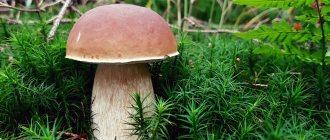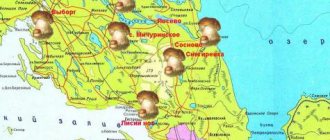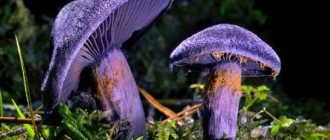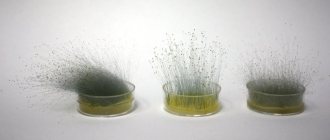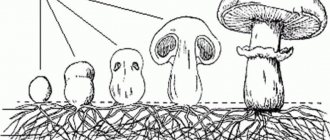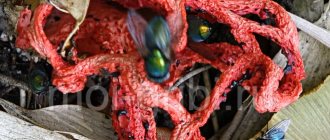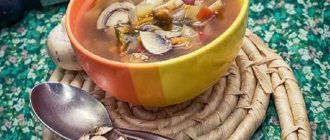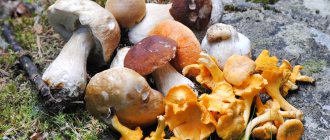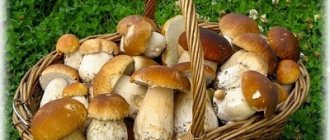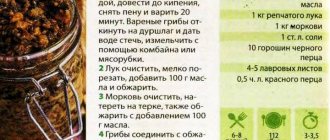We are glad to see you in our “Encyclopedia of Mushrooms”; on the site we have tried to collect the most complete and interesting information about mushrooms found in the CIS. On the pages of our encyclopedia you can find a detailed description of each of the mushrooms with photographs. For mushrooms that can be confused with other so-called double mushrooms, we have made comparative tables by which you can easily recognize them. Our encyclopedia is a kind of journey into the world of mushrooms. Even experienced mushroom pickers will be able to learn a lot of new things on the pages of our encyclopedia, and for those who are just starting to join the mushroom picking hobby, our encyclopedia will undoubtedly be very useful. Here you will find descriptions of the most common mushrooms, as well as their photographs. We have no doubt that this encyclopedia will open to people who love nature another side of it, not only full of amazing charm, but also a kind of sports excitement. Well, then you can’t avoid a delicious lunch, during which, tasting all these mushroom dishes, you’ll forget about any diet. The encyclopedia of mushrooms is divided into three groups, which you can see just below this text. To go to the desired group, click on it with the mouse or select the menu item on the right that interests you. We hope that in our encyclopedia you can find a lot of interesting and new things for yourself, because we tried.
For mushrooms
This application offers a huge reference book with detailed descriptions of hundreds of different mushrooms and high-quality photos.
Which of them can be eaten, where and when they grow, what they can be confused with - here are the answers to all the questions. The main feature of the application is the ability to recognize a mushroom through a smartphone camera. For this purpose, neural networks are used, which at the output offer several most likely answer options. The function is experimental and cannot be trusted 100%, but the detection accuracy is very high.
For mushrooms
Vocom
Price: Free
Download
Price: Free
Encyclopedia of conditionally edible mushrooms
Conditionally edible mushrooms require caution, both when collecting and when preparing for consumption. Before cooking, it is necessary to carry out preliminary measures: fermentation, soaking in several waters, boiling, etc. Such careful processing allows you to remove harmful substances from the mushrooms and improve their taste. The longer these mushrooms are soaked and the more often the water is changed, the tastier they become and the less bitterness they will contain. Conditionally edible include many lamellar mushrooms, the so-called milk mushrooms: milk mushrooms, volnushki, rows, as well as lines, valui, violins, etc.
- Read more…
Mushroom Picker's Guide
This directory app features a more modern interface and easy navigation. From the menu on the left you can quickly jump to the sections of edible and inedible mushrooms. All of them are supplemented with several photos, a description and an indication of the season when they can be collected.
No less useful will be advice and articles that provide answers to many questions about poisonous mushrooms and possible poisoning. There is also a visual calendar showing the seasonality of all mushrooms from the directory. With its help you can find out when is the best time to go to the forest.
Mushroom Picker's Guide
headcorp
Price: Free
Download
Price: Free
Encyclopedia of Edible Mushrooms
We call mushrooms edible, from which you can prepare any dishes without preliminary boiling and soaking. These are the so-called tubular, or spongy, as well as lamellar mushrooms. Tubular got their name because of the small tubes located on the bottom of the mushroom cap, which look like a porous sponge. These are the well-known porcini mushrooms, boletus mushrooms, boletus mushrooms, boletus mushrooms, boletus mushrooms and many others. Lamellar mushrooms include mushrooms on the underside of which there are plates. These are some types of russula, champignons, mushrooms, milk mushrooms, saffron milk caps, chanterelles, etc.
- Read more…
Mushrooms
The simplest reference book, not overloaded with unnecessary information. There are only three sections in it: edible mushrooms, inedible and useful articles. For each mushroom, a description is available indicating other names, classification, nutritional qualities and other useful information.
The app has a favorites feature that makes it easier to access previously marked mushrooms, as well as notes. The latter allow you to leave your comment on any mushroom. Among other things, it is worth noting the function of changing the font and end-to-end search across all content.
Mushrooms
Victor Tokarev
Price: Free
Download
Price: Free
Encyclopedia of inedible mushrooms
Inedible mushrooms also need to be known by sight; although they are not suitable for food, their appearance often resembles many edible ones. Even after pre-processing and boiling, these mushrooms have a bitter taste and unpleasant odor, although they may not contain harmful substances. They can impart a bitter taste to other mushrooms if they accidentally end up in your basket. These mushrooms include pepper mushrooms, gall mushrooms, and soap rows. Particular care should be taken when collecting rows: inedible ones differ from real ones only in a few subtle signs.
- Read more…
Ecoguide - mushrooms and guide
An extensive encyclopedia for iOS containing descriptions of more than 300 types of mushrooms. A guide that takes into account 24 morphological and ecological characteristics will help in recognizing them. There are also many supporting articles and even recipes for various dishes. You can test your own knowledge using a special quiz.
All content of the application is available even without an Internet connection, however, in the free version, photos of mushrooms are shown only in black and white. To access color photographs you need to pay.
Ecoguide - Mushrooms and Key
Ecosystema
Price: Free
Download
Price: Free
Vadim Archer
Mushroom encyclopedia
© V. Archer, text, 2016
© "Tsentrpoligraf", 2016
What you need to know about mushrooms
What are mushrooms
Mushrooms are a cursed breed, created only to confuse the most talented researchers and drive despair to young botanists.
Vaillant
There is probably no person who has not heard of mushrooms. Everyone has seen mushrooms - honey mushrooms, chanterelles, porcini mushrooms, champignons - on store shelves in jars with lids rolled up, on their plate at a holiday or dinner table, salted or fried, with onions and vegetable oil. Many have seen them in a natural setting - in a forest or in a meadow, when they were picking mushrooms with a basket, casually knocking over a toadstool that carelessly poked out of the grass. Nevertheless, scientists of past centuries seriously believed that mushrooms were the creation of the devil, created to confuse taxonomists.
Why? Why didn’t scientists like such delicious mushrooms on a plate? The first taxonomists, without hesitation, classified them as plants - without arms, without legs, standing in one place, not squeaking, not crawling, not biting. But it gradually became clear that there are more differences than similarities between mushrooms and plants.
Firstly, fungi have a hyphal structure, which is not typical of either plants or animals. The above-ground part with a cap and stalk, known to us as a mushroom, is only a fruiting body intended for reproduction. The mushroom itself, or mycelium, consists of the finest threads growing in the substrate - hyphae, or mycelium. If you make a section of the cap or stem of the fruiting body of the mushroom and examine it under a microscope, you will see that they consist of the same hyphae.
Secondly, mushrooms differ from plants in the way they feed. Fungi lack photosynthesis. They feed on ready-made organic substances, decomposing complex organic molecules into simple ones and absorbing them through the shell. For example, they break down fiber into sugars and amino acids. The hyphal structure is ideally adapted to such nutrition, since the mycelium, which is relatively small in volume, has a very large absorption surface. To decompose organic molecules, fungi have developed a complex enzyme apparatus in the process of evolution. Each type of fungus is adapted to its own substrate and has its own set of enzymes for its decomposition.
Thirdly, fungi reproduce by spores. In addition, they can reproduce by pieces of hyphae, which is not typical for spore-bearing plants. In lower fungi, spores are formed by separating the terminal cells; in higher ones, they are formed on the fruiting body in specialized cells - asci or basidia. The spores are similar to pollen, barely visible to the eye; they are very small and light, so they are transported over long distances by water or wind. If conditions are suitable, the spores germinate and the fungus takes root in a new location.
Taxonomists eventually put the devil to shame by classifying fungi into a third kingdom, along with the plant and animal kingdoms. It may not be as prominent a kingdom as the first two, but it is numerous and omnipresent. The science of mushrooms - mycology - currently knows more than 100 thousand species of mushrooms, divided into 5 classes. Among them are fungi of the penicillium group, from which antibiotics are obtained, and all kinds of molds, wood and food, and plant parasites - the culprits of rust and smut in agricultural crops, and parasites of animals and humans that cause lichens and mycoses, and yeast, without which there would be no beer, wine, bread, sauerkraut and even pickled mushrooms.
However, we are primarily interested in mushrooms that you can pick up, break, smell, taste and put in a saucepan or frying pan if they are edible. Such mushrooms are called cap mushrooms - this is not a scientific name, but a collective concept that unites mushrooms of various systematic groups based on their external characteristics. Cap mushrooms include not only mushrooms that have a cap and a stalk, but also those with fruiting bodies of a different shape, such as puffballs or slingshots. The scientific name of these mushrooms is macromycetes, that is, large mushrooms. It is these mushrooms that grow to the delight of mushroom pickers in forests, parks, meadows and other, less romantic places like barnyards and manure heaps. They are described in the mushroom guides aimed at the mass user.
Where to look for mushrooms
Grandfather, darling,
Blow me a whistle
Grandpa, find me
White fungus...
A.N.
Pleshcheev Every mushroom picker is interested in knowing what mushrooms are found in the place where he went with his basket. Most often they go to the forest to pick mushrooms, and, indeed, you can find a wide variety of mushrooms there. However, what this set will be depends on the type of forest.
Mushrooms of pine forests
Pure pine forests grow on very poor sandy soils. The composition of the species of mushrooms found in them depends not so much on the geographical location of the forest, but on its age. In young pine plantings, starting from the second year, late oiler appears, growing in the grass between the rows or under separate trees. The yield of oiler increases every year and becomes greatest when the age of planting reaches 10–15 years, and then begins to fade. When the plantings grow so large that the grass disappears and the soil becomes covered with a layer of fallen pine needles, boletus can be found by the tubercles of raised pine needles. Late oiler bears fruit abundantly almost all summer in the same places, giving 3–4, and in favorable years 5–6 harvests per season.
When pine plantings grow, another abundantly fruiting mushroom appears to replace the late butterfly - greenfinch. Greenfinches grow in large groups and are found in young, middle-aged and mature pine forests, in lowlands in the middle of dense shady pine forests, where they can be detected by slightly raised tubercles of fallen pine needles, and in sunlit forest clearings. In flat areas in pine plantings, the gray row is often found, and a pine variety of porcini mushroom with a yellow-brown cap and a relatively thin, almost cylindrical stalk also grows. The white mushroom usually grows along the edges of plantings, in small depressions and ditches, but is also found among pine trees.
In pine plantings, especially young ones, the autumn or true honey fungus bears fruit abundantly, the families of which grow around the trunks or on stumps left during the sanitary clearing of pine trees. In young and middle-aged pine forests you can find groups of saffron milk caps. They grow in damp places in small depressions, in clearings, forest clearings and edges, and less often in the aisles of pine trees. At the end of summer and autumn, purple moth appears in such places. Sometimes in young pine plantings you can find variegated hedgehog. This mushroom is edible when young, but older mushrooms become tough and bitter.
In damp pine forests, along the outskirts of pine-covered sphagnum swamps, various moss mushrooms and goat grass grow. Here you can also find marsh butterwort, marsh russula, and gray-pink milkweed. In damp places, among the moss, various rows grow in small groups. In young, middle-aged and old pine forests with a small admixture of birch, true chanterelles are found in large numbers, which bear fruit in the same places throughout the summer. Gall fungus is found in mature pine forests. It is not poisonous, but very bitter. At a young age, the gall fungus can easily be mistaken for a white one, so to check, you can lick the flesh of a suspicious mushroom with the tip of your tongue.
In pine forests of middle and older age, various varieties of russula appear in abundance - yellow, blue-yellow, greenish, swamp, brittle, fragrant.
In autumn, in moderately damp, mossy places you can find black podgrudok. In mature pine forests, the Polish mushroom is found, and in clearings with sparse mature pine trees, granular oiler is found. In forest clearings, edges, among sparse forests, the variegated umbrella mushroom grows - one of the most delicious mushrooms - and the red umbrella mushroom - also an edible and tasty mushroom, especially at a young age. Along the edges of old pine forests, gray-pink fly agaric is often found - a conditionally edible mushroom. In pine forests overgrown with weeds, various types of talkers grow abundantly, often forming “witch rings.” Most of them are edible, although of low quality, but some are poisonous. Pages:
Mushrooms: a large encyclopedia
Another detailed guide with the function of recognizing mushrooms through a smartphone camera. As with any other similar application, no one guarantees absolute accuracy, but you can significantly narrow your search with its help.
Another interesting feature is the function of creating photo notes with saving coordinates. It allows you to create your own map of mushroom places for each year. It is also possible to save any articles from the database in the favorites list, so that the main thing always remains at hand.
Mushrooms: Big Encyclopedia
Kosareva Svetlana
Price: 379.00 rubles
Download
Price: 379.00 rubles
Text of the book “The Complete Encyclopedia of Mushrooms”
Tatyana Lagutina Complete encyclopedia of mushrooms
Appeal to lovers of quiet hunting
What a wonderful definition the classic gave to a seemingly prosaic activity - picking mushrooms, the only goal of which is to obtain an additional food product in order to diversify the usual diet or surprise guests with a festive dish with an exquisite taste and divine aroma.
The phrase “quiet hunt” emphasizes the contemplative nature of this event, which is not inferior in level of excitement to traditional hunting or fishing. With his presence, the mushroom picker does not disturb the natural harmony of the morning forest, and his inquisitive and attentive gaze, looking for the desired prey in the grass, does not miss a single, even the smallest, detail of the world, which lives according to its own laws, not subject to the will of man. Contemplation of this world, where every movement is filled with meaning and forms with beauty, invariably puts the mushroom picker in a philosophical mood, makes him think about the vanity of life and once again convinces him of the advantage of the eternal over the momentary. It is not for nothing that many writers were great admirers of quiet hunting, which gave them the opportunity to think about the meaning of life, set life priorities, test creative attitudes, and most importantly, instilled peace in their souls, filled their hearts with admiration, and their minds with wisdom. We address our publication primarily to beginning mushroom pickers who have already felt the passion of a hunter, but have not yet armed themselves with the necessary knowledge to satisfy it. After all, even being quiet, it has all the characteristics inherent in other types of hunting, where one of the main elements is risk. A mushroom that seems harmless at first glance can carry the same danger as a wounded animal or a fish caught on a hook. An experienced hunter, who has dozens of trophies to his name, will never break certain rules. Otherwise, he himself may turn into prey for a more cautious and cunning enemy. Before going into the forest, you need to thoroughly study the habits of its inhabitants, so that you always return home with a basket full of selected, first-class mushrooms and not become a victim of banal ignorance.
The information presented in the book will also be useful to more experienced hunters, since knowledge obtained only from practice is always limited by time and place, but complete and systematized knowledge allows one to expand this framework and obtain deeper and more extensive information, right down to the so-called final product - culinary recipes.
Neither an animal nor a plant: features of the formation and growth of fungi
For centuries, pundits have waged an endless debate about whether mushrooms should be considered animals or plants. On the one hand, they have obvious characteristics of plants: immobility, apical growth, the presence of cell walls, etc. But on the other hand, they are heterotrophic, that is, like animals, they feed on ready-made organic substances, form urea and contain chitin. In addition, the second statement is supported by the fact that mushrooms lack flowers and seeds - constant attributes of most representatives of the plant world. Although mushrooms cannot move from place to place without outside help, as animals do.
Such confusion in the scientific world at the everyday level gave rise to a number of various legends about the origin of mushrooms, in which their occurrence was most often associated with mysterious natural phenomena: a lightning strike, thunderclaps, drops of dew of unprecedented size, etc. In one of the herbalists, dating back to the mid-18th century, mushrooms are even called children of the gods.
Medieval alchemists first tried to give a “scientific” basis for the development of this mysterious organism and explained its growth by the angle of incidence of moonlight. But the first truly scientific theory of the origin of mushrooms was given by the famous French microbiologist L. Pasteur at the beginning of the 19th century. This theory was called “Vis vitalis,” which translated from Latin means “force of life,” and explained the origin of mushrooms by their spontaneous generation. Moreover, the process of spontaneous generation could occur spontaneously, regardless of external factors, without requiring the creation of special conditions.
This theory gave a new impetus to the development of the science of mushrooms and ultimately led to a well-founded conclusion, which marked the beginning of modern mycology: “Any nutrient medium, losing its initial sterility, becomes favorable for the emergence of microorganisms.”
But even after becoming the subject of serious scientific research, mushrooms retained their mysterious cover and posed more and more mysteries to scientists. It is no coincidence that the French botanist Vaillant called them the creation of the devil, capable of driving more than a dozen naturalists into despair. No matter how bold and incredible this definition may seem, it, oddly enough, has some basis. For a long time, scientists could not scientifically explain such a phenomenon as witches’ circles. It was believed that their origin was the result of the activity of evil spirits, for which these same circles served as a kind of testing ground for various events.
Scientific sources record and describe in detail numerous circles of regular shape, the diameter of which reaches 200 m, and the age of 500 years. They are formed by certain types of mushrooms - puffballs, honey mushrooms, fly agarics and chanterelles, etc. In the center of these circles there is a flat area devoid of any vegetation. According to legend, witches held their Sabbaths on it, which gave the name to this mysterious phenomenon.
Another proof of the mystical power of mushrooms was demonstrated over the centuries by the priests of the ancient Mayan Indian tribe. Using the narcotic properties of some of them, they went into a trance and summoned the spirits of deceased leaders, who helped the priests with advice, predicted future events, averted misfortunes and restored health to the sick.
The English zoologist D. Wasson traveled for a long time in South America and collected a wealth of material about the life of its inhabitants. Later, based on his travel notes, he wrote a book where, in particular, he shared his impressions of communicating with American Indians. The author described in detail the ritual rites, the main characters of which were priests in a state of trance caused by the narcotic effect of mushrooms, and gave a scientific basis for this phenomenon.
D. Wasson's book was extremely popular and had a significant influence on the development of the science of mushrooms. Scientists, as if deciding to dispel the mysteries associated with these mysterious organisms, began to study them seriously. Thus, in the middle of the 19th century, the first scientifically based classifications of mushrooms appeared. At the same time, for the first time, from a scientific point of view, the nutritional value of mushrooms was analyzed, which, in turn, gave a new impetus to the development of cooking.
The first mushrooms appeared on our planet several thousand years ago, and their appearance was significantly different from modern ones. Initially, they were of impressive size - individual specimens could reach 3 m in height - and looked like branched trees due to the abundance of lateral processes. Therefore, it is unlikely that it would have occurred to our ancestors to use these giants for food.
As mentioned above, fungi are heterotrophic organisms that feed on ready-made organic substances, which they obtain from the soil or a substrate replacing it, growing trees or stumps. Unlike plants, mushrooms do not have chlorophyll and during their life processes cannot release carbon dioxide from the air.
There is hardly a place on the globe where representatives of the fungal family are not found. Thanks to their extreme unpretentiousness and ability to adapt to various living conditions, mushrooms thrive in the most seemingly unadapted corners of our planet: rocky plateaus, hot springs, permafrost and sun-scorched desert.
But such independence of mushrooms from external conditions is only apparent. In fact, they, like any living organism, need certain factors that determine their appearance and development. Thus, the determining circumstance for the emergence of a particular type of fungus is the presence of an “accommodating” neighbor. Its role is most often played by a tree. The mushrooms enter into a kind of agreement with it, under the terms of which the plant gives the mushrooms part of the carbohydrates, receiving nutrients in return, including nitrogenous ones. This attraction of mushrooms to the community is reflected in the names of some of them - boletus, boletus, boletus, etc.
Despite the fact that there are more than a hundred species of fungi in nature, they are all usually divided into two large groups: unicellular and multicellular. Although in everyday life we most often encounter the lower forms of fungi - single-celled ones: yeast, mucor fungi that cause diseases in humans, animals and plants, etc., we will not dwell on them. In our book we will talk about higher forms, since they are the main subject of our interest.
The structure of a multicellular fungus consists of underground and above-ground parts. The underground part is the mycelium, or mycelium, and the above-ground part is the fruiting body, consisting of a stem and a cap. The caps of almost all young mushrooms have a convex shape. This is due to the fact that they are forced to break through a thick layer of soil to make their way to the surface. And only in the process of above-ground development do mushroom caps develop species differences. With age, they acquire a flat, funnel-shaped, concave or bell-shaped shape. Depending on the type, the stems of mushrooms also have their own characteristics: they can be long or short, thick or thin, straight or slightly curved, etc.
Rice. 1.
Types of mushroom stems and caps: a – stems;
1 – cylindrical; 2 – tuberous; 3 – swollen; 4 – narrowed to the base; 5 – thickened towards the base; 6 – with a ring; 7 – leg with vagina
Rice. 1 (continued).
Types of mushroom legs and caps: b – caps;
1 – with a tubercle; 2 – convex; 3 – plano-convex; 4 – depressed; 5, 6 – funnel-shaped; 7 – ovoid; 8 – bell-shaped
If you examine the inner surface of the cap under a microscope, you can see the spores with which the mushrooms reproduce. Their diameter ranges from 3 to 200 microns. They come in a variety of shapes and shades that include yellow, purple, pink and brown. Thus, by the appearance of the spore, you can accurately determine which type of fungus it belongs to.
Each mushroom has a large number of spores, which have a huge supply of vital energy and retain the ability to germinate for decades. Mature spores, falling on the ground, are spread across it by the wind or with the help of animals and birds. Some of them make long journeys, crossing seas and oceans, hiding in the plumage of migratory birds.
Even when in favorable conditions, not all spores germinate at the same time. Most of them remain in the ground for some time and wait in the wings. If a miracle happened and all the spores sprouted at the same time, life on Earth would be in jeopardy. After all, just one medium-sized champignon contains more than 10 billion spores under its cap, which it can spread in just 6–7 days.
Rice. 2.
Fungal spores
Once in the ground, the spore begins to germinate and forms hyphae - microscopically thin, simple or branching threads, from which the mycelium and fruiting bodies of mushrooms are subsequently formed. The mycelium, as a rule, is located at a shallow depth - 6-10 cm, since its development requires a constant flow of fresh air.
Depending on the type of mushroom, the lifespan of its mycelium can be several days, months or even years. Moreover, the mycelium of certain species, under unfavorable climatic conditions or as a result of mechanical damage, can stop its growth and seem to go into hibernation. At the end of the difficult period, the mycelium is revived and begins to bear fruit.
Close observation of the process of mushroom development led scientists to unravel the mystery of witch circles. It turns out that the culprits of their occurrence are hyphae, which, forming mycelium, diverge from the center in different directions, forming rays of equal length. Along their entire length, fruiting bodies subsequently grow on the soil surface. But over time, the soil feeding the mycelium becomes depleted, the hyphae die off, and the mycelium grows in breadth in search of more fertile soil. “Round dances”, as a rule, occur in an open place, since in the forest the strict geometry of the mycelium is disrupted by the chaotic arrangement of trees encountered along its path.
Rice. 3.
Witches circle
The parameters of the average mushroom are quite modest: its height is 10–15 cm, and its weight is 100–200 g. But here, too, there are some records. Science has recorded facts when the mass of the mushroom reached 7 kg. The case is quite rare, giving mushroom pickers a reason to dream about such a gigantic catch.
Another record that belongs to all representatives of the mushroom family without exception. They are by far the fastest growing organisms. In 1–2 days, from barely hatched shoots they turn into mature fruits, ready to take their place in the basket or, with the help of spores, give life to a new generation of mushrooms.
Mushrooms grow best in warm, humid weather. Deviations in one direction or another significantly slow down their growth, and severe drought or prolonged rains can lead to its cessation.
Currently, there are several classifications of mushrooms. Following one of them, fungi are usually divided into two classes of approximately equal numbers, each of which includes approximately 30 thousand species: basidiomycetes, or basidiomycetes, and marsupials, or ascomycetes. A distinctive feature of representatives of the first class are special reproductive organs - basidia, located on the lower surface of the caps. A characteristic feature of marsupial fungi is their peculiar sporulation organs, similar to bags - asci. Moreover, asci can be located both on the surface of the fruiting body (in morels) and inside it (in truffles).
Depending on the structure of the lower part of the cap, mushrooms are divided into lamellar, tubular and blackberry. In agaric mushrooms, the bottom of the cap consists of many thin plates, on the surface of which there are billions of spores. If the same number of spores were placed on a flat and smooth surface, the size of the cap would increase 15–20 times. Lamellar caps have saffron milk caps, russula, milk mushrooms, champignons, chanterelles and others.
The bottom of the cap of tubular mushrooms has a tubular structure and looks like a sponge, hence their second name - spongy. A large number of small vertical tubes are ideal for sowing mature spores into the soil. Tubular mushrooms include porcini mushrooms, boletus mushrooms, boletus mushrooms, boletus mushrooms, boletus mushrooms, boletus mushrooms, and others.
The spiky bottom of the cap is much less common. Its resemblance to the spiny back of a hedgehog is the reason why mushrooms with such a cap are called blackberry mushrooms. These include hornworts, or clubworts, and blackberries.
Following another classification based on the place where mushrooms grow, mushrooms are divided into forest, meadow and garden.
According to the type of nutrition, fungi can be divided into xylotrophs, growing near trees and feeding on them, saprotrophs, growing in open areas and feeding on the rotting remains of organisms, coprotrophs, growing in soil rich in organic fertilizers, and, finally, carbophiles, growing in the soil, rich in carbon (ash, coal).
In addition, all cap mushrooms are divided into edible, inedible and poisonous. Edible mushrooms are eaten without any restrictions. They do not pose any danger to humans, have high taste and contain a large number of useful elements. Certain types of mushrooms, such as morels and sour mushrooms, contain small amounts of toxic substances. But as a result of heat treatment, these substances disintegrate and become absolutely harmless. But, when going to the forest, remember that mushrooms have excellent absorbent qualities, so you should not collect them near roadways or places where harmful substances are released, since they contain a large amount of absorbed poisons.
Inedible mushrooms, or mildly poisonous ones, are not eaten due to their bitter and unpleasant taste. As for the poison they contain, its amount is so insignificant that it cannot cause serious harm to the human body. Examples of inedible mushrooms are gall and satanic mushrooms.
The poison contained in most poisonous mushrooms is not inferior in strength and effect on the human body to that of a snake, so eating such mushrooms usually leads to death. In this regard, the first thing a novice mushroom picker must learn is to distinguish edible mushrooms from poisonous ones. This is the key to a happy outcome of a quiet hunt.
Which mushroom is better, or there is no dispute about tastes (nutritional value of mushrooms)
Mushrooms are a unique product that best combines high taste and an abundance of substances beneficial to the human body. In terms of their chemical composition, they are close to meat and fish, so for a long time during long fasts in Rus', mushrooms were the main source of proteins and dishes made from them were present in the daily diet. Every self-respecting cook kept secret recipes for preparing mushroom dishes and passed them on by inheritance, first orally, and with the advent of writing - in the form of scrolls or in notes to chronicles. Dishes prepared from porcini mushrooms were often served at the royal table, causing delight and envy of overseas gourmets.
We have already said that mushrooms contain a large amount of proteins. Moreover, the amino acids included in their composition - such as tyrosine, histidine, leucine and arginine - enter the intestines, are easily broken down and quickly absorbed, normalizing the functioning of the gastrointestinal tract.
Lecithin present in mushrooms prevents the formation of cholesterol in the body, and a daily dose of zinc and copper, which play an important role in the process of hematopoiesis, can be obtained by eating only 100 g of honey mushrooms. In addition, mushrooms contain some types of fats, carbohydrates and enzymes, as well as trace elements - fluorine, potassium, magnesium, iron, sodium, sulfur and chlorine. Porcini mushrooms, chanterelles and saffron milk caps contain a large amount of vitamin A, while boletus mushrooms contain vitamin PP1 - almost as much as liver and yeast. In terms of vitamin B1 content, mushrooms can be placed on a par with grain crops, and in terms of the amount of vitamin D - with butter. Mushrooms owe their excellent taste to the presence of sugars in them, and their exquisite aroma to the presence of essential oils and resins.
Speaking about the nutritional value of mushrooms, one cannot fail to mention their only, in our opinion, drawback. This disadvantage lies in the fact that mushrooms are very difficult to digest due to the presence of certain nitrogen-containing substances in them, in particular fungin. In its chemical composition, fungin is very similar to chitin, the basic element of crustacean shells.
Based on taste and the amount of nutrients, mushrooms are usually divided into four categories. The first - highest - category includes porcini mushrooms, saffron milk caps, as well as real and yellow milk mushrooms. One step below are the boletus, boletus, oak, boletus and champignon. The third place is occupied by chanterelles, morels, honey mushrooms and moss mushrooms. Rounding out the classification are rubella, bitter mushroom, row mushroom, and oyster mushroom, which experienced mushroom pickers avoid.
Simple rules for picking mushrooms
Before you go into the forest, carefully study the specialized literature, especially those that are equipped with color illustrations depicting edible and poisonous mushrooms. And only after you learn to distinguish edible mushrooms from inedible ones, you can take a basket and start testing the theory with practice. It would be good to stock up on a pocket reference book so that at first, in case of difficulty, you can compare the forest beauty with its photograph on the page of the book.
You need to go out on a quiet hunt with the first rays of the sun, when drops of dew shimmer on the shiny mushroom caps, thereby revealing the presence of their owners even in the most secluded and hidden places. In addition, the dormouse risks being left without prey, which will go to the one who went out onto the forest path before him in search of the treasured trophy.
As for the mushroom picker’s equipment, it must meet the main and, perhaps, the only requirement - to be comfortable. Therefore, put on your feet well-worn closed shoes without heels, which will protect you from the morning dew and will not cause trouble during long walks. Even in warm weather, throw a windbreaker over your shoulders. This is a good remedy for insects and prickly spruce and pine needles. For special hunting equipment, take a sharp knife to cut off the stems of mushrooms, a light stick with a small spear at the end to rake fallen leaves, and a basket for collected mushrooms. It goes without saying that instead of a basket, you can take any other container suitable for this purpose. But a wicker basket allows you to keep mushrooms whole and fresh thanks to its rigid structure and the holes between the rods that provide air access.
Since mushroom picking is a fun and exciting process that makes you forget about time, it can last for several hours and take you several kilometers away from home. Therefore, it would be a good idea to take with you several sandwiches, a plastic bottle of water and a box of matches. It would be nice to put a compass in your pocket. But if it is not there or you do not know how to use it, carefully remember the road so as not to get lost in the forest.
Do not rush to leave the place where you found at least one mushroom. The fact is that mushrooms do not grow alone, and where there is one, most likely there will be a whole family. Do not pull the mushroom out by the roots, but carefully cut it at the base with a knife. This way you will not damage the mycelium and next year you will be able to find new prey in the same place.
If the mushroom you cut turns out to be wormy or does not suit you for any other reason, do not throw it on the ground, much less trample it. Place it on a twig or tree branch. There, forest dwellers can feast on it, and the released spores will fall to the ground to shelter there from future cold weather.
Do not put the cut mushroom into the basket immediately. First, use a knife to clear it of debris, cut off the wormy areas and the old tubular layer. This way you will save yourself from the tedious process of processing mushrooms at home.
In order for the mushrooms to retain their original appearance on the way home, it is advisable to place brittle and soft mushrooms - such as russula or summer mushrooms - separately from strong ones - porcini, boletus or aspen.
And one last thing. Do not disturb the harmony that surrounds you in the forest. Don't compete with nature by trying to outshout birds or breaking tree branches to clear a path for yourself. Listen to the silence around you, take a closer look at the beauty of the pristine world, feel like a part of it, and who knows, maybe you will return from the forest not only with a full basket, but also with a renewed soul and a light heart.
Mushroom catalog Mushroom mania
What are mushrooms and how to understand them?
Mushrooms, by nature, are considered special representatives of our planet Earth, therefore they are classified as a separate and completely independent kingdom of living organisms. They are no longer plants, but at the same time, they are clearly not yet animals and, according to a number of characteristics, occupy an intermediate position between plants and animals. That is why, over the years, they have been so difficult to define and systematize. So to this day this issue has not yet been fully resolved.
all mushrooms on gribomaniya.ru
In order to accurately recognize mushrooms, learn to understand them well, know a lot about them and be able to tell about them, you need to carefully read this photo-reference book-classifier, which presents a simple and useful to any “naturalist” fungal taxonomy, including:
- squads
- ranks
- sections
- subgroups
- types
mushrooms, which, according to the period of ripening and fruiting, have different:
- seasons
and, according to their consumer and nutritional value, are also divided into:
- categories
But someone may also be interested in a more in-depth knowledge of mushroom classification, or its interpretation from a scientific point of view, including:
- groups
- departments
- classes
- orders
- families
- childbirth
- kinds
the diversity of fungi currently available.
Why is this guide about mushrooms needed?
The directory, in a broad sense, is the “alphabet of mushrooms” with truisms, based on the rich experience of our ancestors, and published for those who are clearly interested in collecting forest “trophies” and essentially understand what “silent hunting” is; as well as for those who are just about to join this “cult community.”
Frankly speaking, the direct reason for this publication was the not very reliable and not very fair information about the “kingdom of mushrooms” presented on the “World Wide Web”. I would like to hope that the good impulse to “put everything in its place” will not be in vain, and the publication presented to the “viewer’s judgment” will be useful to those uninitiated in the business of mushroom picking, interesting amateurs and curious professionals.
Beginning mushroom pickers can study the types of mushrooms and become familiar with their taxonomy, as well as understand how to identify suitable and unsuitable species, and learn to navigate the forest if they suddenly find themselves “lost in three pines.” Experienced hobbyists (who “already know everything”) can get acquainted with the scientific classification of mushrooms (an entire section is dedicated to it) and their difference from other living organisms inhabiting the planet. Experienced “aces” (mushroom picking professionals) can read the instructions when:
- breeding
mushrooms in your garden (on your personal plot). And housewives, together with adherents of “miracle medicine”, remember about mushroom:
- cooking
- medicine
filling the “gaps” of daily leisure.
What do you need to know when going mushroom hunting?
First of all, regardless of the degree of your own training (both amateurs and experienced mushroom pickers), you should carefully read and remember the simple rules of a mushroom picker about:
- behavior
- orientation
in the forest, and of course about:
- collection
gifts of the forest, as well as about them:
- recycling
- workpiece
- storage
- use
so as not to destroy nature and once again not expose yourself to unnecessary danger.
Should you pick mushrooms or not?
Today (as, indeed, always) “quiet hunting” gives both pleasure and invaluable health benefits because picking mushrooms, in principle, differs from the concepts of fishing in a radically different approach to the matter: you won’t be able to sit here for a long time, here “you’ll drown, So you’ll eat it.” A trip to the forest to pick mushrooms is comparable to physical therapy - after all, the process takes place in the lap of wildlife and does not require any financial costs (except for the cost of travel). This type of active recreation was, is and of course will have many fans, turning it from an ordinary hobby into a non-trivial need!
